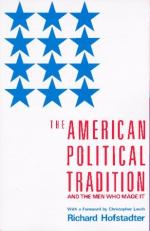
|
| Name: _________________________ | Period: ___________________ |
This test consists of 15 multiple choice questions and 5 short answer questions.
Multiple Choice Questions
1. Which groups of people did the Southwesterners wish to give voting rights?
(a) Non-white males.
(b) Property owners.
(c) All soldiers.
(d) Non-property owners.
2. Which group of Americans did Thomas Jefferson distrust the most?
(a) Elected leaders.
(b) Laborers.
(c) Merchants.
(d) Farmers.
3. How does Hofstadter describe Abraham Lincoln's concern over the issue of slavery in America?
(a) Fierce.
(b) Weak.
(c) Strong.
(d) Mild.
4. What did the Founders design the Constitution to protect?
(a) Freedom from interference.
(b) The laws of the nation.
(c) The nation from outside forces.
(d) The government from the people.
5. On the American frontier, how was social hierarchy gained?
(a) Through political power.
(b) Through military and financial success.
(c) Through invention and industry.
(d) Through family connections and marriage.
6. Who won the presidential election in 1832?
(a) Andrew Jackson.
(b) John C. Calhoun.
(c) Henry Clay.
(d) John Floyd.
7. What was the Constitution based upon?
(a) Greek and Roman political philosophy.
(b) Experience and observation.
(c) Fragments of English political philosophy.
(d) European tradition mixed with revolutionary philosophy.
8. How does Hofstadter describe Thomas Jefferson's foreign policy?
(a) Liberal.
(b) Defensive.
(c) High Representative.
(d) Non-interventionist.
9. What philosophy did John C. Calhoun have about African-Americans?
(a) They wanted someone to take care of them.
(b) They were naturally inferior to Anglo-Saxons.
(c) They were capable of great deception.
(d) They were naturally wild and dangerous.
10. Why did Andrew Jackson want to close down the bank or force inflation?
(a) To change the method of loan assumption.
(b) To create a new bank with his own investors.
(c) To allow for the privatization of banking.
(d) To reduce the debt burden on land speculators.
11. How many Southern states had seceded before Abraham Lincoln took office?
(a) Six.
(b) Five.
(c) Seven.
(d) Three.
12. According to Hofstadter, how is Andrew Jackson often depicted?
(a) As one of the most influential men in history.
(b) As an arrogant aristocrat.
(c) As an aggressive proponent for military conquest.
(d) As an opponent of aristocratic privilege.
13. What concern did Abraham Lincoln have about secession?
(a) Its legality.
(b) The division of families.
(c) Its morality.
(d) The loss to the economy.
14. How does Hofstadter describe Andrew Jackson's economic policies?
(a) Laissez-faire.
(b) Socialist.
(c) Corporate capitalism.
(d) Mercantile.
15. What did John C. Calhoun believe capitalism would produce?
(a) A stronger economy.
(b) Survival of the fittest.
(c) Political power.
(d) Exploitation of the poor.
Short Answer Questions
1. How did the Founders plan for legislature to be processed?
2. To what does Hofstadter attribute the failure of John C. Calhoun's political career?
3. How long did Abraham Lincoln initially plan for the war to last?
4. How did Andrew Jackson acquire massive debts?
5. How did Wendell Phillips place himself in danger?
|
This section contains 467 words (approx. 2 pages at 300 words per page) |

|




